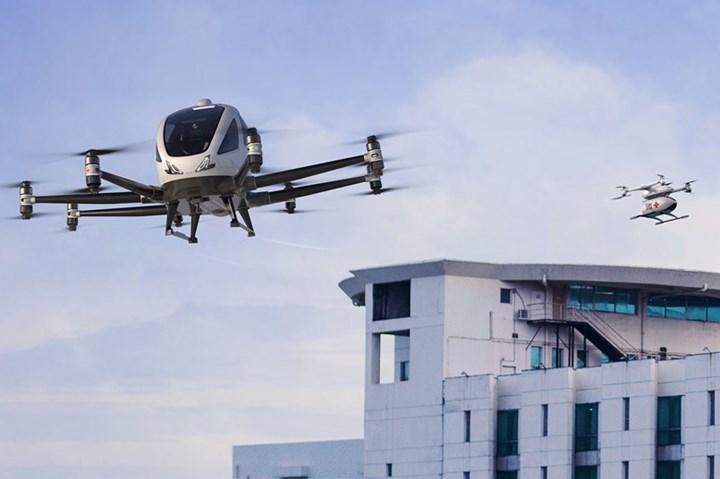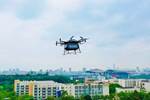EHang to demonstrate eVTOL medical air mobility via SAFIR-Med project
Project intends to demonstrate AAV use cases for emergency medical transport, and potentially advance and refine current U-space services for unmanned aircraft in European airspace.

Photo Credit: EHang Holdings Ltd.
EHang Holdings Ltd. (Guangzhou, China) announced on Feb. 5 its participation as the only passenger eVTOL partner in the SAFIR-Med (Safe and Flexible Integration of Advanced U-Space Services for Medical Air Mobility) project, a research and innovation project to promote the use of unmanned aviation in healthcare systems across the European Union (EU).
The project, which aims to ensure that healthcare is of high quality and accessible to all citizens of the EU, has selected 17 partners from eight countries and is supported by eight cross-industry advisory board members including the European Aviation Safety Agency (EASA) and The Red Cross. Within two years, the project intends to demonstrate advanced U-Space services, a set of new services relying on the digitalization and automation of functions and specific procedures designed to help ensure unmanned aircraft operate in a safe, secure and connected environment. These include detect-and-avoid as a service, dynamic geofencing and air traffic prioritization rules.
EHang will use EH216, its flagship two-seat passenger-grade autonomous aerial vehicle (AAV), and its Falcon medium-sized AAV to transport medical supplies in urban environment. The demonstrations will take place in collaboration with healthcare providers like hospitals and medical spaces in the cities of Antwerp (Belgium), Aachen (Germany), Heerlen (the Netherlands) and Maastricht (the Netherlands), leveraging the MAHHL trans-border region. The project results will then be further demonstrated in two additional locations in Europe, namely Athens, Greece, and Prague, Czech Republic. Prior to the operational environment demonstrations, a de-risking exercise at the DronePort BVLOS test-facility in Belgium will take place.
Using its expertise and abundant experience, EHang says it will help formulate a performance assessment and recommendations report, which will refine the current U-space architecture principles, propose operational procedures and mechanisms for an effective interface between air traffic control (ATC) and U-Space service providers, and suggest a set of urban air mobility (UAM) indicators to complement the existing smart urban mobility indicators used by European cities. The project is among several managed by the SESAR (Single European Sky ATM Research) Joint Undertaking in an effort to deliver solutions for U-space, the European Commission's initiative on the safe and secure integration of drones in European airspace.
Participation in the SAFIR-Med project reportedly marks another milestone for EHang in Europe following two major UAM programs, the AMU-LED project supported by the European Union and the Re.Invent Air Mobility initiative launched in the Paris region. Leveraging its past regulatory breakthroughs and comprehensive partnership network, EHang will expand its global flight tour to more cities and showcase its leading AAV products and solutions in various use cases including passenger commuting and emergency medical transport, etc. As one of the world's first listed UAM company to achieve global commercialization of its passenger-grade AAVs, EHang adds that it is also well positioned to work with all parties to facilitate product innovations and construction of a UAM legal framework in Europe.
Related Content
-
Composites end markets: Pressure vessels (2024)
The market for pressure vessels used to store zero-emission fuels is rapidly growing, with ongoing developments and commercialization of Type 3, 4 and 5 tanks.
-
Infinite Composites: Type V tanks for space, hydrogen, automotive and more
After a decade of proving its linerless, weight-saving composite tanks with NASA and more than 30 aerospace companies, this CryoSphere pioneer is scaling for growth in commercial space and sustainable transportation on Earth.
-
Composites opportunities in eVTOLs
As eVTOL OEMs seek to advance program certification, production scale-up and lightweighting, AAM’s penetration into the composites market is moving on an upward trajectory.
















